Advance Reservation of Network Resources for Multimedia Applications
- 格式:pdf
- 大小:35.55 KB
- 文档页数:11

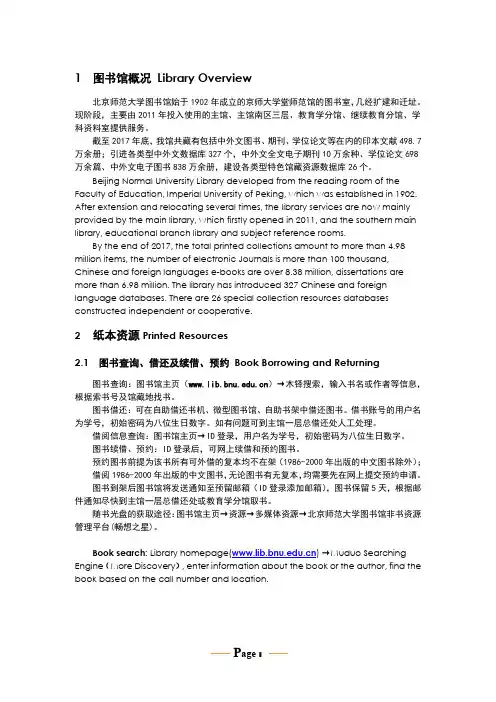
1图书馆概况Library Overview北京师范大学图书馆始于1902年成立的京师大学堂师范馆的图书室,几经扩建和迁址。
现阶段,主要由2011年投入使用的主馆、主馆南区三层、教育学分馆、继续教育分馆、学科资料室提供服务。
截至2017年底,我馆共藏有包括中外文图书、期刊、学位论文等在内的印本文献498.7万余册;引进各类型中外文数据库327个,中外文全文电子期刊10万余种、学位论文698万余篇、中外文电子图书838万余册,建设各类型特色馆藏资源数据库26个。
Beijing Normal University Library developed from the reading room of the Faculty of Education, Imperial University of Peking, which was established in 1902. After extension and relocating several times, the library services are now mainly provided by the main library, which firstly opened in 2011, and the southern main library, educational branch library and subject reference rooms.By the end of 2017, the total printed collections amount to more than 4.98 million items, the number of electronic Journals is more than 100 thousand, Chinese and foreign languages e-books are over 8.38 million, dissertations are more than 6.98 million. The library has introduced 327 Chinese and foreign language databases. There are 26 special collection resources databases constructed independent or cooperative.2纸本资源Printed Resources2.1图书查询、借还及续借、预约Book Borrowing and Returning图书查询:图书馆主页()→木铎搜索,输入书名或作者等信息,根据索书号及馆藏地找书。
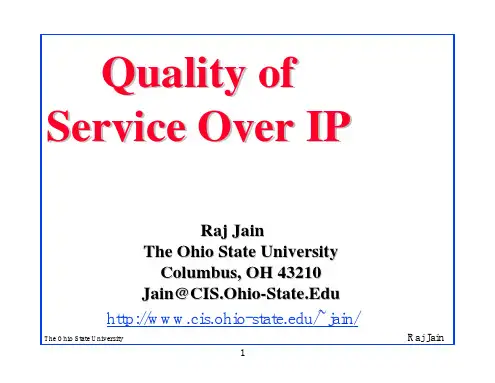
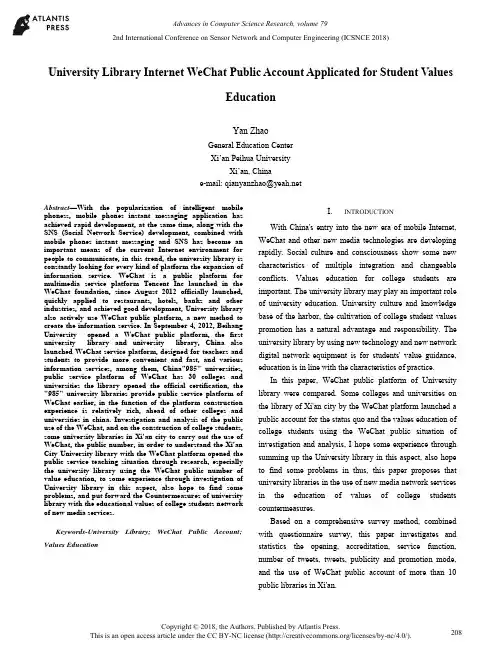
University Library Internet WeChat Public Account Applicated for Student ValuesEducationYan ZhaoGeneral Education CenterXi’an Peihua UniversityXi’an, Chinae-mail:********************Abstract—With the popularization of intelligent mobile phoness, mobile phones instant messaging application has achieved rapid development, at the same time, along with the SNS (Social Network Service) development, combined with mobile phones instant messaging and SNS has become an important means of the current Internet environment for people to communicate, in this trend, the university library is constantly looking for every kind of platform the expansion of information service. WeChat is a public platform for multimedia service platform Tencent Inc launched in the WeChat foundation, since August 2012 officially launched, quickly applied to restaurants, hotels, banks and other industries, and achieved good development, University library also actively use WeChat public platform, a new method to create the information service. In September 4, 2012, Beihang University opened a WeChat public platform, the first university library and university library, China also launched WeChat service platform, designed for teachers and students to provide more convenient and fast, and various information services, among them, China"985" universities, public service platform of WeChat has 30 colleges and universities the library opened the official certification, the "985" university libraries provide public service platform of WeChat earlier, in the function of the platform construction experience is relatively rich, ahead of other colleges and universities in china. Investigation and analysis of the public use of the WeChat, and on the construction of college students, some university libraries in Xi'an city to carry out the use of WeChat, the public number, in order to understand the Xi'an City University library with the WeChat platform opened the public service teaching situation through research, especially the university library using the WeChat public number of value education, to some experience through investigation of University library in this aspect, also hope to find some problems, and put forward the Countermeasures of university library with the educational values of college students network of new media services.Keywords-University Library; WeChat Public Account; Values EducationI.INTRODUCTIONWith China's entry into the new era of mobile Internet, WeChat and other new media technologies are developing rapidly. Social culture and consciousness show some new characteristics of multiple integration and changeable conflicts. Values education for college students are important. The university library may play an important role of university education. University culture and knowledge base of the harbor, the cultivation of college student values promotion has a natural advantage and responsibility. The university library by using new technology and new network digital network equipment is for students' value guidance, education is in line with the characteristics of practice.In this paper, WeChat public platform of University library were compared. Some colleges and universities on the library of Xi'an city by the WeChat platform launched a public account for the status quo and the values education of college students using the WeChat public situation of investigation and analysis, I hope some experience through summing up the University library in this aspect, also hope to find some problems in thus, this paper proposes that university libraries in the use of new media network services in the education of values of college students countermeasures.Based on a comprehensive survey method, combined with questionnaire survey, this paper investigates and statistics the opening, accreditation, service function, number of tweets, tweets, publicity and promotion mode, and the use of WeChat public account of more than 10 public libraries in Xi'an.2nd International Conference on Sensor Network and Computer Engineering (ICSNCE 2018)II.ANALYSIS OF WECHAT PUBLIC ACCOUNT OFUNIVERSITY LIBRARY IN XI’ANA.Xi'an University library WeChat public accountconstruction and development statusBy the end of 2017, all the university libraries in Xi'an had opened the WeChat public account, including Northwestern Polytechnical University library, Shaanxi Normal University library and Chang'an University library as subscription numbers, and others as service numbers. The library of Xi'an Jiao Tong University was opened in July 2013. It is the first university in Xi'an to open WeChat public account. Northwestern Polytechnical University, Northwestern University and Xi'an Electronic and Science University were launched in March 2015, July and 11, accounting for 42.8%. The opening time of Northwest Agriculture and Forestry University, Shaanxi Normal University and Xi'an Peihua University was in June 2016, October and November, accounting for 28.6% of the proportion.1)Analysis of the service content of the WeChat public account in the university library of Xi'anAccording to the author's investigation, the WeChat public account in most university libraries provides a custom content service. The public library WeChat set custom menu options according to their own characteristics, custom content retrieval service covers the lending service to provide a collection of query, retrieval, borrow, and continued (borrow), booking books and other services; information push service, including the announcement of the news, switching time and other services; reading promotion service including the book recommendation, collection, distribution, online bookstore, book recommendation; the library service, including training room / seat reservation, borrowing rules, common problems, card services, contact us. Chang'an University library, WeChat public provide extension services to the lost and found; WeChat Public Library of Northwestern University, the China Institute Library will also guide new service in the custom menu, easy to understand the use of new library services and resources.In the library of WeChat public service mode, Xi'an Jiao Tong University, Northwest Agriculture and Forestry University, Northwestern Polytechnical University, Northwestern University, 4 university libraries provide self-service WeChat public consultation, including Northwest Agriculture and Forestry University, Northwestern Polytechnical University library for the user, the system reply all numbers with the keywords, users need to reply system provided by the number or keyword library related service regulations. The library system of Xi'an Jiao Tong University and Northwestern University reverted to the way of searching and querying, WeChat binding and other contents. The library also provided QQ and telephones contact. Xi'an Electronic and Science University library provides similar real-time interactive consultation, according to user questions to extract keywords, keyword answer system based on user consultation, the content of the answer is still several digital options or search keywords, only on the relatively detailed answer, targeted and relatively higher specificity. However, there is a response deviation caused by inaccurate keyword extraction, which is still unable to meet the user's personalized consultation demand. The WeChat public account of the Shaanxi Normal University and the Chang'an University library has not provided consulting services. The Xi'an Peihua University is more specific to push the new book appreciation.2)Analysis of the service content of the WeChat public account in the university libraryAccording to the author's investigation, the WeChat public account in most university libraries provides a custom content service. The public library WeChat set custom menu options according to their own characteristics, custom content retrieval service covers the lending service to provide a collection of query, retrieval, borrow, and continued (borrow), booking books and other services; information push service, including the announcement of the news, switching time and other services; reading promotion service including the book recommendation, collection, distribution, online bookstore, book recommendation; the library service, including training room / seat reservation, borrowing rules, common problems, card services, contact us. Chang'an University library, WeChat public provideextension services to the lost and found; WeChat Public Library of Northwestern University, the China Institute Library will also guide new service in the custom menu, easy to understand the use of new library services and resources.In the library of WeChat public service mode, Xi'an Jiao Tong University, Northwest Agriculture and Forestry University, Northwestern Polytechnical University, Northwestern University, 4 university libraries provide self-service WeChat public consultation, including Northwest Agriculture and Forestry University, Northwestern Polytechnical University library for the user, the system reply all numbers with the keywords, users need to reply system provided by the number or keyword library related service regulations. The library system of Xi'an Jiao Tong University and Northwestern University reverted to the way of searching and querying, WeChat binding and other contents. The library also provided QQ and telephones contact. Xi'an Electronic and Science University library provides similar real-time interactive consultation, according to user questions to extract keywords, keyword answer system based on user consultation, the content of the answer is still several digital options or search keywords, only on the relatively detailed answer, targeted and relatively higher specificity. However, there is a response deviation caused by inaccurate keyword extraction, which is still unable to meet the user's personalized consultation demand. The WeChat public account of the Shaanxi Normal University and the Chang'an University library has not provided consulting services. The Xi'an Peihua University is more specific to push the new book appreciation.B.Analysis use of university library WeChat publicaccount in Xi'anIn 2017 10-12, the author conducted a survey of 10 colleges in Xi'an City, mainly adopts the simple random sampling method, the questionnaire and the use of the public library, WeChat exchange students from 10 universities, mainly college students basic information, the use of WeChat, WeChat, the public library and the public library on WeChat push the contents of investigation on College Students' values influence. A total of 460 questionnaires, 448 valid questionnaires, the questionnaire response rate was 97.39%, analysis of the survey results can be seen the basic characteristics of the subjects of this research, the professional grade, a relatively balanced ratio of respondents mainly to undergraduate students (90.8), the use of WeChat for more than a year accounted for 87.5% of the respondents, compared with a representative sample.According to the survey can be found in the library using the WeChat platform, students use the library to understand the WeChat public school/library events accounted for 67.9%, accounted for 60.9% of the educational resources, access to bibliography, broaden the vision of college students accounted for 37.3% and 36.8% using the library WeChat platform, and 20.5% of students choose entertainment / send time. More than half of the college students used the library WeChat platform to pay attention to 68.1%, 67.4% and 62.7% of leisure, education and social life respectively. Through the library WeChat platform, concerned about current affairs politics, literature education, science and technology experiment, the number of college students who want to be enlightened is also a few, accounting for 43.8%, 40.4% and 32.1% respectively.If the Reading Library WeChat platform push on values to enhance bibliographies and tweets, 48% of respondents choose around here, choose carefully accounted for 10.5%, 29.2% of respondents said they would see the mood at that time, only 3.6 of respondents said they would not read. To evaluate the function of WeChat library platform,72% person feels it is useful; 17% feels it is just common and 11% feels it is lack of information, shown as Figure 1..Figure 1.Evaluate of the function of WeChat platform in universitylibraryIII.SOME ISSUES NEED TO BE SOLVEDA.The university library is not enough to push the WeChatpublic account.“How to get the WeChat public platform information” in the school library, the teachers and students to recommend the most, accounting for 46%, accounting for 44.2% of the school website, the library publicity activities and library websites / micro-blog recommended were accounted for 43.1% and 36.2%, issued a notice on the counselor accounted for 13.8%.B.The service content of the university library's WeChatpublic is not rich.Library's use of public account tweets content is also mainly based on database / resource usage instructions, lecture announcements and bulletin boards. The publicity of values is done more through the aspects of "good books to read" and other columns. At present, the WeChat public account of the university library is very few in the ideological and political education.C.The role of the WeChat public in values education is notoutstanding.College students are willing to read and accept the library WeChat push bibliography and information; at the same time the push type indirect spread of values such as education, practice on paper than direct Indoctrination Theory on the propaganda more easily lead to college students' interest; subject of humor use network language more tweets get relatively more praise.IV.COUNTERMEASURES OF WECHAT PUBLIC ACCOUNT FOR COLLEGE STUDENTS VALUES EDUCATIONA.Tobuild the public account of the university librarywith the characteristic brandMake full use of the advantages of WeChat university library, tap their own resources to develop new forms of the carrier, the use of written language expression, affinity rich content, the integration of existing services and tweets, build long-term push has a certain reputation tweets than columns, such as to improve the integration of the existing WeChat public account in various "recommended read" column, launched 1-2 columns, the number of monthly / weekly push without too much, with the tweets of high quality, the cultivation of College Students' values imperceptibly.B.Integrate the existing resources of the WeChatpublic accountAt present, the WeChat public account of the university library has very little content to carry out the ideological and political education propaganda values. Can fully tap the school history, famous expert deeds red resources, the integration of the existing school characteristic resources, strengthen propaganda guidance will dig out late, the red school history, advanced people inside and outside the school to fully display the true story, making the core values of the mainstream display platform, so that students in the true story of people around the infection through the positive publicity, enhance the value of deeper understanding.C.Set up a professional WeChat operation team toimprove the quality of serviceThe routine work of University library in the guarantee of quality of service at the same time, can build up a professional operations team in the WeChat Museum, invited the expert teachers of Humanities and Social Sciences, psychology guidance for students' reading psychology, tweets from the form, title, text, content and other aspects of design, will Chinese excellent traditional culture classics, humanities and Social Sciences classics, Chinese characteristic socialism theory system and so on, has positive energy culture beneficial things for transformation of the values of college students, can attract readers in content and form.D.Ensure line and line coordinationIn the WeChat online promotion at the same time, the relevant line museum activities cannot be a mere formality, WeChat promotion is just the first step, the library should be more careful to do online follow-up activities, and will continue to carry out follow-up posted on the WeChat public account, do detailed introduction to launch activities, release moments, released a wonderful message the activity, knowledge contest, increase the positive ideological and political education interest, improve students through the activities of attention participation, so that WeChat canachieve promotion effectively, improve college students' values.V.CONCLUSIONIn conclusion, the current Shaanxi university library is developing the library's traditional business on the platform of WeChat public. Meanwhile, it has opened various uses of WeChat public number, such as publicizing good books, communication between teachers and students, and values education for college students. From the current application and development situation, the overall service situation is optimistic, but based on the University library in the school environment and humanistic values of college students in the cultivation of special status, and the current WeChat is still in continuous development, technology also change rapidly, more powerful, so that university library should adapt to the development trend of the times, change under the new media environment of the service concept, make full use of WeChat to improve its service, strengthen the propaganda, improve the content, enhance students' sense of identity for the school, improve the school connotation and visibility, the public library, WeChat really serve in the mainstream platform of values education.REFERENCES[1]Liu Jing, China's University library certification user micro-bloginvestigation and analysis - Sina micro-blog as the platform [J], the library Study, 2012 (01):90-95[2]Hu Xuanzhen university library, micro-blog fine service of [J],library work and study, 2014 (04): 36-38[3]Kong Yun, Library Mobile Information Service Research Based onWeChat public account [J], information magazine, 2013 (9): 167-171 [4]Ye Haizhi, and [J], mobile information service of the library basedon the design of the WeChat software guide, 2013 (11): 88-90[5]Han adorable, development of information service by WeChat publicplatform of University library on [J], Library Journal, 2014(10):111-115[6]Shayne Bowman, Chris Willis, We Media-How audience are shapingthe future of News and information[M], The Media Center, 2003, 6 [7]Zhang Yihan. University library to carry out WeChat serviceexploration [J]. modern business industry, 2015 (7): 92-93[8]Qiu Y ubing. Micro media era college library resources promotion --a case study of WeChat [J]. service as an example of Henan LibraryJournal, 2015 (4): 38-40[9]Yang Rongrong. The investigation and analysis of the digitalreference service in University library and Its Development Countermeasures -- taking 100 national exemplary university libraries as an example, [J]. library research, 2015 (2): 97-101。
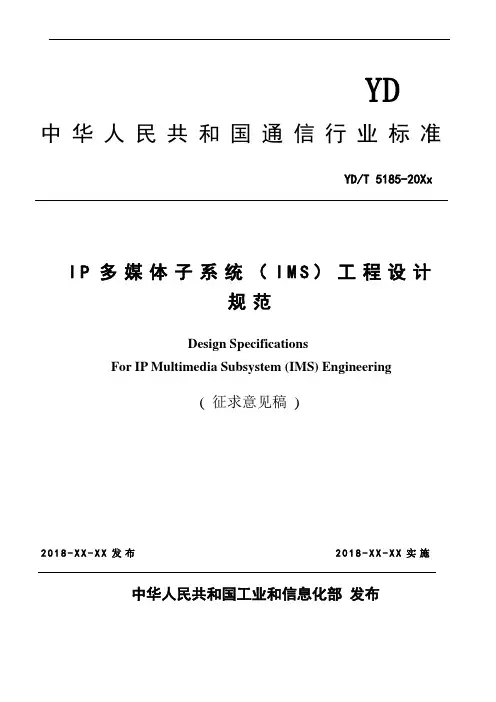
( 征求意见稿 )YD/T 5185-20Xx I P 多媒体子系统(I M S )工程设计规范 Design SpecificationsFor IP Multimedia Subsystem (IMS) Engineering 中华人民共和国工业和信息化部 发布 2018-X X -X X 发布 2018-X X -X X 实施 YD 中华人民共和国通信行业标准中华人民共和国通信行业标准I P多媒体子系统(IMS)工程设计规范Design SpecificationsFor IP Multimedia Subsystem (IMS) Engineering(征求意见稿)主管部门:工业和信息化部信息通信发展司批准部门:中华人民共和国工业和信息化部施行日期:2018年XX月XXXXXX 出版社2018 北京前言本规范是根据“工业和信息化部办公厅关于印发2016年第二批行业标准制修订计划的通知”(工信厅科〔2016〕110号)的要求,对YD/T 5185-2010《IP多媒体子系统(IMS)工程设计暂行规定》的内容进行了修订,并补充了VoLTE IMS、虚拟化IMS(vIMS)等内容,对IMS(含VoLTE)系统工程的方案制定、工程设计起到重要指导作用,为IMS网络的建设和设计提供相应的依据。
本规范的主要内容包括:IMS网络能力、系统架构及功能、网络结构及节点设置、IMS 网络功能虚拟化架构及设置、网络组织、路由原则、漫游和游牧、地址和号码、网间互通、信令和IP带宽计算、设备配置、服务质量指标及IP承载网要求、计费、网络管理、网络安全、同步、设备安装工艺要求等。
本规范由工业和信息化部信息通信发展司负责解释、监督执行。
本规范在使用过程中,如有需要补充或修改的内容,请与工业和信息化部信息通信发展司联系,并将补充或修改意见寄工业和信息化部信息通信发展司(地址:100804)。
本规范由中国通信企业协会通信工程建设分会组织编制。
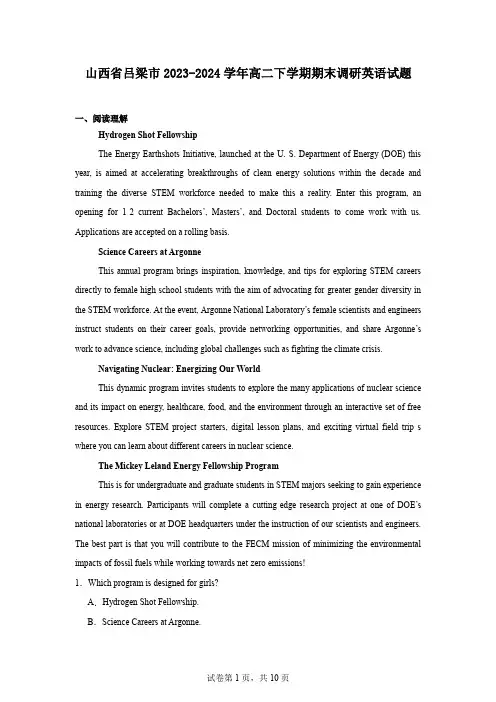
山西省吕梁市2023-2024学年高二下学期期末调研英语试题一、阅读理解Hydrogen Shot FellowshipThe Energy Earthshots Initiative, launched at the U. S. Department of Energy (DOE) this year, is aimed at accelerating breakthroughs of clean energy solutions within the decade and training the diverse STEM workforce needed to make this a reality. Enter this program, an opening for 1-2 current Bachelors’, Masters’, and Doctoral students to come work with us. Applications are accepted on a rolling basis.Science Careers at ArgonneThis annual program brings inspiration, knowledge, and tips for exploring STEM careers directly to female high school students with the aim of advocating for greater gender diversity in the STEM workforce. At the event, Argonne National Laboratory’s female scientists and engineers instruct students on their career goals, provide networking opportunities, and share Argonne’s work to advance science, including global challenges such as fighting the climate crisis.Navigating Nuclear: Energizing Our WorldThis dynamic program invites students to explore the many applications of nuclear science and its impact on energy, healthcare, food, and the environment through an interactive set of free resources. Explore STEM project starters, digital lesson plans, and exciting virtual field trip s where you can learn about different careers in nuclear science.The Mickey Leland Energy Fellowship ProgramThis is for undergraduate and graduate students in STEM majors seeking to gain experience in energy research. Participants will complete a cutting-edge research project at one of DOE’s national laboratories or at DOE headquarters under the instruction of our scientists and engineers. The best part is that you will contribute to the FECM mission of minimizing the environmental impacts of fossil fuels while working towards net-zero emissions!1.Which program is designed for girls?A.Hydrogen Shot Fellowship.B.Science Careers at Argonne.C.Navigating Nuclear: Energizing Our World.D.The Mickey Leland Energy Fellowship Program.2.What can students do in Navigating Nuclear: Energizing Our World?A.Go on virtual field trips.B.Start different careers.C.Research with nuclear scientist.D.Get network opportunities.3.What do the four programs have in common?A.They are energy-related.B.They are STEM programs.C.They target undergraduates.D.They aim to tackle climate crisis.A 63-year-old Chinese carpenter’s (木匠) traditional skills have become an unexpected Internet hit as he creates woodwork with a single piece of wood, without glue, screws or nails. Wang Dewen, known as “Grandpa Amu” on YouTube, has been praised as the modern-day Lu Ban, a well-known Chinese structural engineer during the Zhou Dynasty, thanks to his rich carpentry knowledge.Grandpa Amu’s most popular video, which shows him making a delicate wooden arch bridge, has gone viral on YouTube, gaining more than 40 million views. “If you do something, you have to love it, and you have to be interested in it; however, being interested doesn’t mean there’s only happiness and no pain.” Grandpa Amu shared when talking about his excellent carpentry skills.His most popular works include a folding stool, a model of the China pavilion from the 2010 Shanghai Expo, and an apple-shaped interlocking puzzle, known as a Lu Ban lock. Grandpa Amu follows an ancient Chinese mortise and tenon (榫卯) technique, which means no nails or glue are involved in the entire process of building the arch bridge.The master carpenter has also made several wooden toys for his grandson using the same technique. His young grandson’s favorites include a walking Peppa Pig and a bubble blowing machine. With over 1.17 million fans on YouTube, Grandpa Amu’s videos so far have gained more than 200 million views.His wonderful woodworking skills were developed from the age of thirteen as a way of supporting his family in East China’s Shandong Province. “The grandson is so happy, as there have been so many fine and unique toys made by grandpa from an early age,” commented onenetizen, while another said, “It’s amazing. I hope these traditional crafts can be passed on!”4.What do we know about Grandpa Amu from the first paragraph?A.He is made fun of on the Internet.B.He aims at spreading Chinese culture.C.He has made a lot of fortune on the Internet.D.He is well known for his carpentry skills on the Internet.5.What can we infer from Grandpa Amu’s words in Paragraph 2?A.Outstanding skills lie in hard work.B.Success depends on passion.C.Interest brings not merely happiness.D.Theory is from practice.6.What is the unique feature of Grandpa Amu’s craft works?A.The apple shape.B.No nails or glue.C.The folding stool.D.The wooden material.7.What probably made Grandpa Amu work as a carpenter?A.His interest in woodworking.B.His grandson’s requirement.C.His support for his family.D.His wishes to pass on the traditional crafts.In most Hollywood movies, the Native American Navajo s still fight on horses in the American Southwest. But during World War II, a group of Navajos made their language into a weapon to protect the United States. They were the Navajo Code Talkers, and it is one of the few unbroken codes in military history.Navajo was the perfect choice for a secret language. It is very complex. One vowel (元音) can have up to ten different pronunciations, changing the meaning of any word. In the 1940s, Navajo was unwritten language. No one outside of the reservation (居留地) could speak it or understand it.The Navajo Code team had to invent new words to describe military equipment. For example, they named ships after fish: lotso-whale(battleship), calo-shark (destroyer), beshloiron-fish (submarine). When a Code Talker received a message via radio, he heard a series of unrelated Navajo words. He would then translate the words into English and use the first letter of each English word to spell the message. The Navajo words tsah (needle), wol-la-chee (ant), ah-kh-di-glini (victor), and tsah-ah-dzoh (yucca) spelled NA VY.The Code Talker kept the code a secret. They memorized everything. There were no code books. As a result, no ordinary Navajo soldiers, if captured by the enemy, could understand the code. More than 3,600 Navajos served in World War II, but only 420 were Code Talkers with the US Marines. They coded and decoded battlefield messages better and faster than any machine. They could encode, transmit, and decode a three-line English message in 20 seconds. Machines of the time required 30 minutes to perform the same job.Even after the war the code remained top secret. When they were asked about their role, Code Talkers just said: “I was a radioman.” War movies and histories came out without mentioning them. The code was never used again and only in 1968 did the secret come out. 8.Why could Navajo be used as a military code?A.It had a complex writing system.B.It was designed specifically for World War Ⅱ.C.Only the Navajos could understand it.D.Navajo words varied greatly in pronunciation. 9.What would the Navajo Code team do right after receiving a message?A.Put it into English in a secret way.B.Record it in Navajo letters.C.Put the Navajo words in order.D.Submit it to the officer immediately. 10.What is paragraph 4 mainly about?A.Heroic deeds of Navajo Code Talkers.B.Working contents of Navajo Code Talkers.C.The difficulty of becoming a Navajo Code Talker.D.The professionalism of Navajo Code Talkers.11.What can be inferred from the passage?A.The Navajo Code Talkers can be found to fight on horses in US movies.B.Around 12% Navajo soldiers were taken prisoners during World War Ⅱ.C.War messages were translated into English through Navajo code books.D.The Navajo language contributed a lot to the US army in World War Ⅱ.Developed by Urban Villages and designed by Studio Gang, Populus will open in the summer of 2024 as America’s first carbon-positive hotel. Studio Gang took inspiration from the patterns of Colorado’s native Aspen trees, with the building’s windows looking like the trees’ distinctive “Aspen Eyes”.Situated in downtown Denver, the hotel will achieve its carbon-positive status thanks to itssustainable design and a unique off-site project. The hotel has committed to planting enough trees to represent over 5,000 acres of forest. This will offset an embodied (隐含的) carbon footprint equal to nearly 500,000 gallons of gas and remove additional carbon dioxide from the atmosphere.Populus has been created to meet the increasing preference by today’s consumers to travel responsibly, experience places in an authentic way, and connect more deeply with nature. Using low-carbon concrete, high-recycle content materials, and minimizing waste are all helping the hotel reach its carbon-positive goal. There is also no planned on-site parking, which will encourage visitors to take public transportation or use existing structures, thus saving the hotel from having to build a parking lot, which requires the use of materials rich in carbon.When thinking about the look of the hotel, Studio Gang turned to nature for its design inspiration. And the building’s unique windows, not only recall the pattern of the Aspen tree but also help its energy efficiency. The “covers” over each window provide interior shade, which improves energy use and also channel away rainwater to keep the building looking clean.As a benefit to guests, each room will have incredible views and the windows transform into seats or desks that invite them to enjoy the great outdoors—even when they’re inside.The hotel will also include a rooftop restaurant that overlooks the mountain s and city skyline, with the intention to immerse guests in nature. The rooftop will be open to the public and will be filled with regional vegetation, serving as a lush (草木茂盛的) place for the community to socialize.12.What does the underlined word “offset” in paragraph 2 mean?A.Produce.B.Cancel.C.Include.D.Require. 13.What do we know about Populus?A.It has planted over 5,000 acres of trees.B.It is designed to meet the demands for environmental travel.C.It can’t be accessed through driving for no planned on-site parking.D.It will include a rooftop restaurant open to the public for free.14.What’s the author’s attitude toward the hotel?A.Doubtful.B.Indifferent.C.Positive.D.Disapproving. 15.What can be a suitable title for the text?A.Populus: First Carbon-Positive Hotel in America B.Populus: A Hotel in DowntownDenverC.Populus: Contributor to the Change of America D.Populus: A Hotel with “Aspen Eyes”It is a great challenge of descriptive writing: finding that balance between using enough details to bring your description to life, but not so much that your readers are fed up with it. 16 Remember, you’re writing a description, not taking a photograph. 17 If you were photographing a tree, you would still make choices — lighting, framing, focus — that would capture the essence of the tree, but not its exact image.Trust your readers. Stephen King says in On Writing, “Description begins in the writer’s imagination, but should finish in the readers.” 18 If you offer an exactly right description — rather than a complete description — the readers’ completion of your description will be close enough to what you want them to “see” in the picture.19 If you write this: “Wind stirred (吹动) the maple’s boughs, spurring leaves to wavelike a million green hands greeting them to hurry to its shady embrace”, you have created a real description, and you don’t need to write that the tree is big.Let actions take the place of description. This can be effective in describing emotions. Instead of “Sue felt sad as she stared at their wedding photo.”, try “Sue stared at their wedding photo until her stinging eyes could no longer focus. She turned the photo face down on her nightstand.” We now know, through her actions, that Sue is sad. 20 That is because we’re experiencing her physical reactions (stinging eyes) and actions (turned the photo face down) along with her.A.Focus on readers’ emotions.B.Readers can fill in the picture.C.Describe facts instead of actions.D.Embrace the use of metaphors and similes.E.It is not necessary to document every detail.F.Besides, we now feel more connected with her in that sadness.G.Fortunately, there are techniques you can use to find that balance.二、完形填空I have always been a big girl. I am comfortable with my body but there is a price to pay for being 21 .In primary school, I was enthusiastic about gymnastics but I had to 22 my shortcomings by hours after hours of extra practice, going over every routine. It took months to master the ribbon (带子), which I used to get in a terrible 23 . However, I carried on and 24 greatly so that in2015 I was in the National Championships Final.Whenever I went up in a 25 , I always got the sense that the crowd did not expect much from the overweight child before them. They 26 about my weight in low voices. One man even said,“That’s the ugliest leotard (紧身衣) I’ve ever seen and the elephant inside it isn’t much 27 !”I felt 28 . Trying to smile away the tears, I decided to let my ribbon do the talking. I had worked particularly hard on my ribbon and it showed. On the first beat I knew it was to be 29 . I was gliding (滑行) on the music, each move under 30 control. Soon the whispers of the crowd turned to cheers. As I went into that last split leap, the crowd 31 . I turned to face them and found each one on their feet, applauding. It was incredible.I was titled National Champion that year, but the best thing I got from hours of 32 practice was the knowledge that my look cannot determine who I am and should never limit what I can do. Society seems to 33 that overweight people are unhappy with their weight and have little 34 , so they never amount to much. What a ridiculous guess! I believe I can achieve anything 35 I am bigger than my body. Who wants to be ordinary anyway? 21.A.famous B.beautiful C.responsible D.different 22.A.live up to B.make up for C.break away from D.put up with 23.A.mess B.order C.mass D.length 24.A.developed B.changed C.improved D.slimmed 25.A.class B.competition C.organization D.conference 26.A.knew B.heard C.cared D.commented 27.A.better B.thinner C.heavier D.faster 28.A.excited B.hurt C.moved D.disappointed29.A.ordinary B.popular C.excellent D.inspiring 30.A.remote B.steady C.automatic D.accurate 31.A.rushed B.gathered C.erupted D.left32.A.tiring B.general C.nervous D.scientific 33.A.indicate B.believe C.know D.hope 34.A.freedom B.respect C.equality D.confidence 35.A.if B.even if C.because D.though三、语法填空阅读下面短文,在空白处填入1个适当的单词或括号内单词的正确形式。
Advance Reservation of Network Resources forMultimedia Applications
Wilko ReinhardtTechnical University of Aachen (RWTH Aachen), Dept. of Computer Science (Informatik IV)Ahornstr. 55, 52056 Aachen, Germanyemail: wilko@informatik.rwth-aachen.de
Abstract. To guarantee Quality of Services for continuous media like audio andvideo, intermediate nodes in networks must be able to reserve resources like buffercapacity, CPU time and bandwidth. Several methods have been introduced toverify that new connections can be accepted by the network without violatingguarantees made for already established connections. One drawback of all pro-posed admission control algorithms is that they accept the reservation only atconnection establishment time. It is not possible to reserve resources in advance.This paper introduces an algorithm that allows the user to reserve the desired QOSin advance. The paper further describes how the signalling of advance reservationcan be realized using the Internet Stream Protocol ST-2.
1IntroductionCommunication support of distributed multimedia applications imposes several chal-lenges on today's communication systems. The requirements of these applications reveala lack of performance of traditional protocol stacks. Major reasons are contradictorydemands made by the various media types. On one hand, isochronous data streams fromlive video and audio sources request high bandwidth, timely delivery of the data and lowdelay variation (jitter). On the other hand, asynchronous streams resulting e.g. from thetransfer of still images or textual documents need a reliable transmission but can acceptsome delays and are insensitive to jitter. Broadband networks (e.g. B-ISDN, DQDB,FDDI, FDDI II, etc.) were developed in recent years, providing sufficient bandwidth tosupport the various requirements. Thus, the problem lies within the functionality andperformance characteristics of the network and transport layers [5]. A new generation ofprotocols is necessary to bridge the functional and performance gap within these layers.XTP [10] and ST-2 [8] are two of the very promising approaches besides experimentalapproaches from several research laboratories [3,9]. The common part of all theseprotocols is the extended support of Quality of Service (QOS) parameters, allowing theuser processes to define their exact requirements for the requested connection. Inaccordance with the QOS values the protocol functionality is configured and/or resourcesare reserved to provide a guaranteed service.
The 'real' support of QOS, i.e.. not just OSI's 'request and pray' approach is a key issue forsufficient communication support of multimedia applications. Currently, several ex-tended QOS semantics are under discussion:
IWACA'94•Threshold QOS: The service user specifies 'worst case' values which are accept-able as the lowest quality. If values fall below these thresholds the user process willbe informed so that it can decide to accept the lower quality or abort theconnection. The QOS concept introduced by the OSI 95 project [1] proposes amore rigorous semantics, called compulsory QOS: If only one of the 'worst case'values is exceeded the connection will be aborted immediately.
•Guaranteed QOS: [2] introduced the guaranteed QOS semantics which has arather strong legal flavour. When a service provider guarantees a performancevalue to the service user, it commits itself to provide that performance and to paya penalty if the negotiated value can not be achieved. On the other hand the serviceuser is obliged not to exceed the negotiated value.
Guaranteed QOS assumes that all intermediate nodes from the source to the destinationallocate appropriate resources like bandwidth, buffer space and CPU time. Theseresources are exclusively used by the data streams the reservation was made for. Aprotocol for the negotiation of the QOS values and the corresponding reservations isneeded. Examples of resource reservation protocols are ST-2 or RSVP [11]. Thereservation protocol is a vehicle to transmit the user demands to the several networknodes. In general, it works independently from the routing and the admission controlalgorithms. The admission control algorithm is responsible to check if sufficientresources are available to serve the desired new connection without violating agreedperformance parameters for already established connections.
A common drawback of all resource reservation protocols is that there is no possibilityto reserve the resources in advance. This paper introduces an approach to solve thisproblem by presenting the necessary changes in the admission control procedure and theresource reservation protocol. Chapter 2 gives a brief introduction to ST-2 as an examplefor a reservation protocol. Chapter 3 describes an extension of intermediate nodes tomanage the advance resource reservation. The necessary extensions of the resourcereservation protocol are explained on the basis of ST-2 in chapter 4. The paper closes witha discussion of the approach in chapter 5.